A brief but long-lasting moment occurred on 19 May 2012, one that would awaken me to the changing realities in our neighborhood since the January 25 Revolution. It was late at night, while standing on my balcony overlooking Cleopatra Square, Alexandria, at the height of the first leg of the 2012 presidential campaign. A scuffle broke out between a group of political campaigners tearing up posters of candidate Amr Mousa, and shop owners and residents who supported Mousa. I ran down to film the incident, only to be tackled by undercover “security” who mistook me as part of the group. One yelled: “We are taking you to army headquarters.” Then a voice was heard: “Leave him, he is one of us” (as in to say, a resident of the area). It turned out to be my barber. In exchange for letting me go, I had to delete the video footage—which I pretended to do but did not.
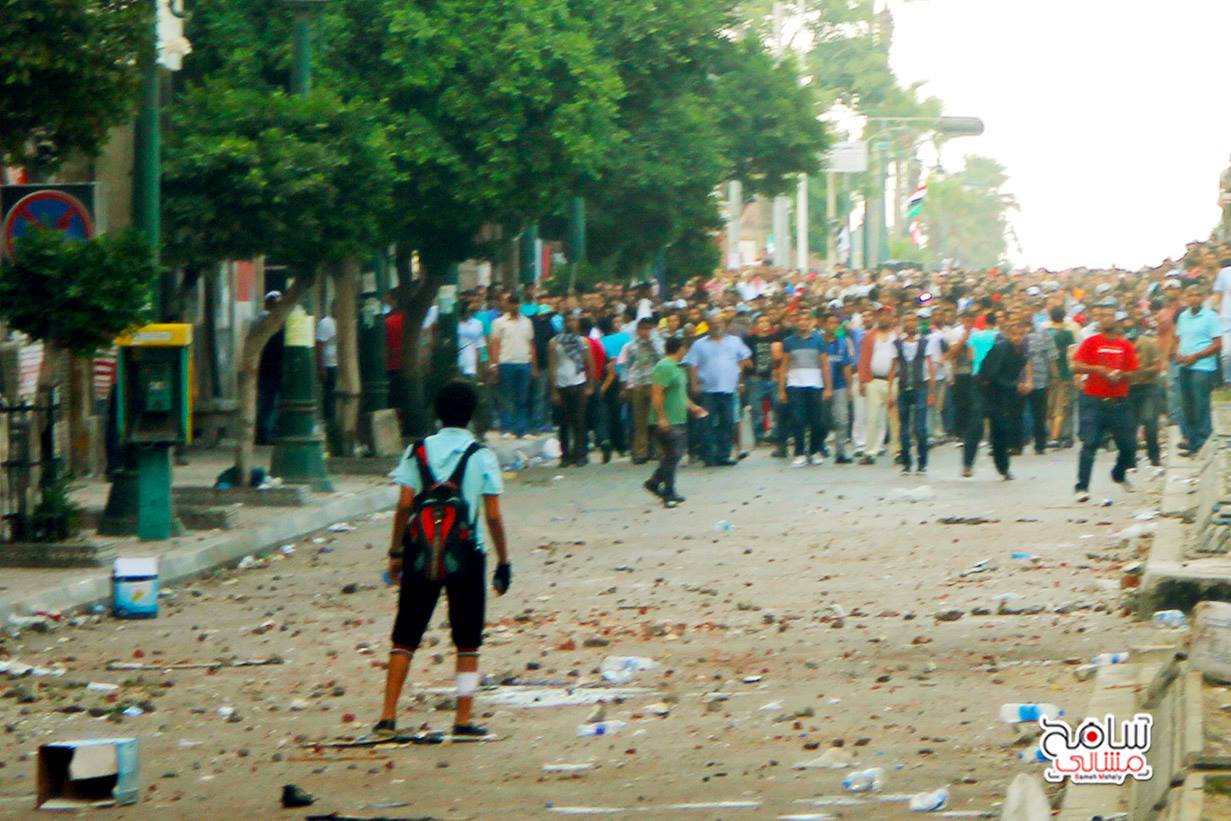
[Pro-Morsi supporters clash at Sidi Gaber on 28 June 2013. Photo by Sameh Meshally]
I took a few steps back in disbelief. Someone I had trusted turned out to apparently be a part of an informal former regime loyalist network. This same group has attacked revolutionary protest marches that pass frequently through this area with bottles and knives. This same Port Said Street was the site of several human chains formed by former regime loyalists in order to prevent revolutionary protests from moving on, often unsuccessfully.
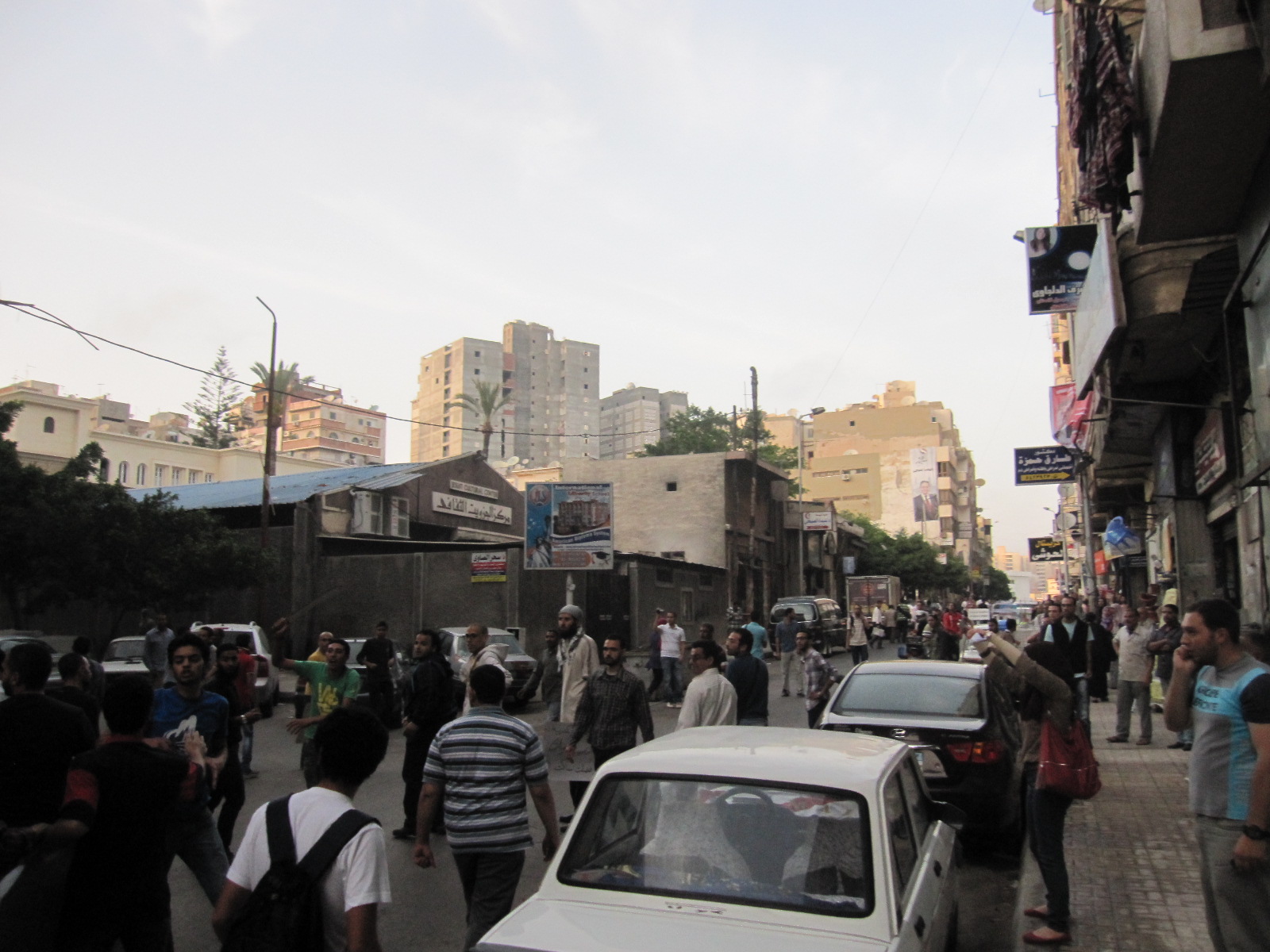
[The first wave of surprise attacks by former regime loyalists on anti-SCAF protesters, 3 May 2012. Photo by Amro Ali]
The motives behind their actions soon become apparent.
Stroll some one hundred meters or so, and you end up in Sidi Gaber–Alexandria’s budding Tahrir Square, second only to, or possibly eclipsing, the Qa’id Ibrahim Mosque courtyard–where the military’s fiercely guarded northern command headquarters is based. The barber and his friends see themselves as the first line of defense against encroachment on the “guardians of the nation.” Whether they were paid or not, I could not verify.
Sidi Gaber recently featured fierce protest violence during the pro-Morsi demonstrations on 5 July. Out of the thirty deaths across Egypt, a staggering seventeen occurred in Sidi Gaber alone. This includes the heart-wrenching video of what appeared to be pro-Morsi supporters throwing two teenagers over a ledge, resulting in the death of one of them. A week earlier, American student Andrew Pochter was stabbed to death in the same area.
What makes Sid Gaber a powder keg of upheaval, in my view, is the unfortunate placement of conflicting landmarks. When the military command, the armed forces hospital, two offices belonging to the Muslim Brotherhood’s Alexandria headquarters, a notorious police station, and a major node of public transportation are in the same district, trouble is around the corner.
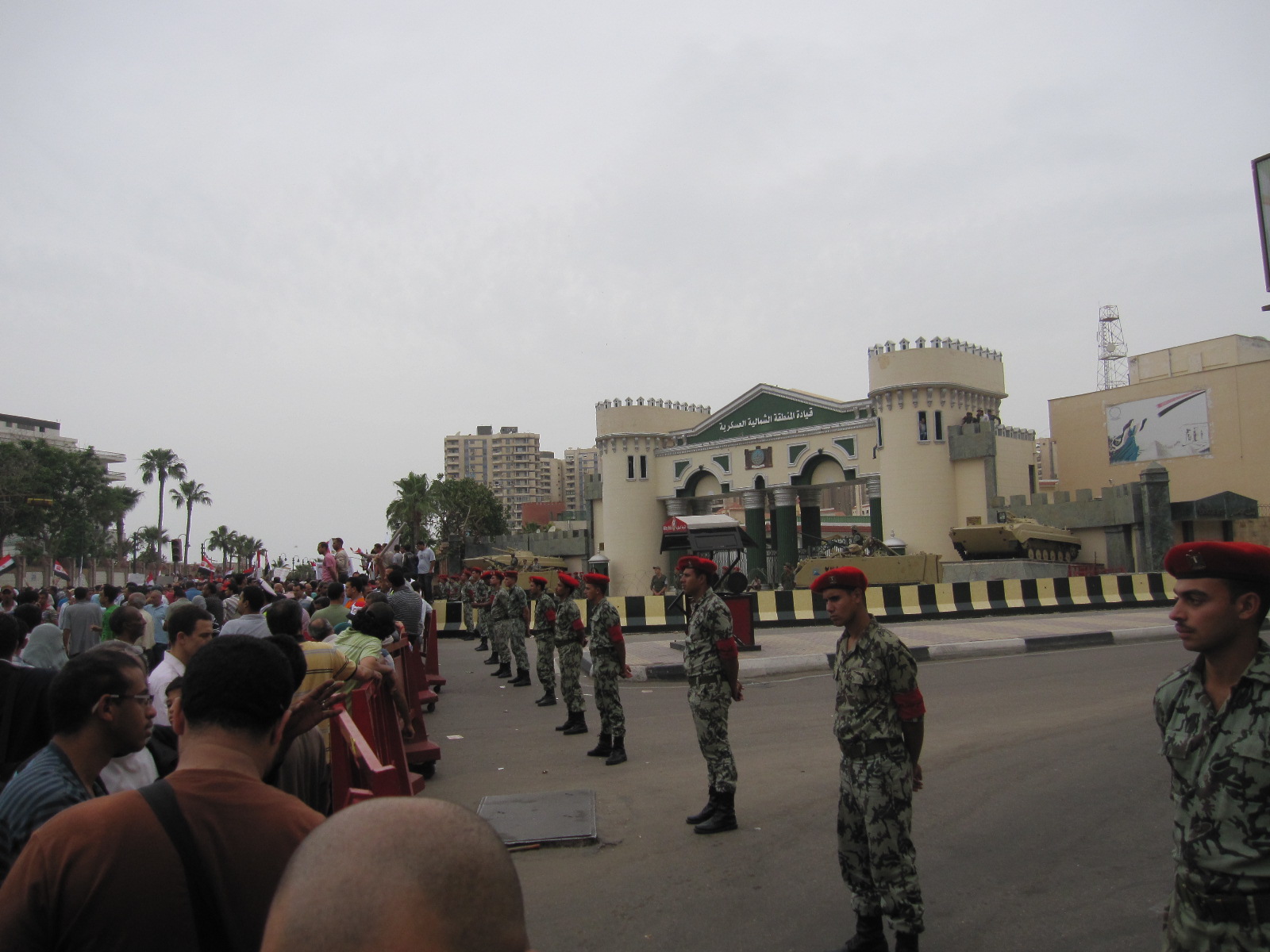
[Protest marches often finish and remain at the front gates of the Northern Military High Command. Photo by Amro Ali]
The area’s functional importance is a result of its perception as a nodal point that “connects” west and east Alexandria, and can be first glanced from taxi and microbus drivers who use Sidi Gaber to mentally calculate if charges will increase when they pass it. It is, however, the Sidi Gaber train station—one of the two major train stations in the city—which raises the gravitational pull for commuters and protesters alike. Furthermore, three major roads intersect through Sidi Gaber: while Port Said Street ends here. The coastal street and Abou Quer Street cut through it. Such factors aid in the rapid mobilization of protesters, and increase the likelihood of clashes. When Sidi Gaber Square is occupied by huge numbers, it paralyzes the traffic flow in several spots, which is one of the aims of major protests. As one protester says, “It is to send the message that you cannot disregard us and ignore our presence—[that] we will impact your daily routine.”
The value of the Sidi Gaber train station for protesters cannot be overemphasized. According to the paper "Public Involvement in Sustainable Development: A Public Participation Process in the Sidi Gaber Railway Station Development Project, Alexandria, Egypt”— written by S.S.A. Aly and M.S.E. Amer–the train station was built in the 1850s. It is the oldest train station in Egypt, predating even Cairo’s Ramses Station. It was the first train station constructed outside Europe, and would eventually seep into the popular imagination. For revolutionaries, it is symbolic of its connection to the Cairo state and its ability to inhibit a good section of the economy when shut down. Also often overlooked is the arrival of Islamist protesters from Kafr-El-Sheikh, the reserve depot of Salafis, to the Sidi Gaber station and main bus stop. On 3 July, Tamarod Campaign protesters struck early in the morning by obstructing the railway tracks and initiating a civil disobedience campaign.
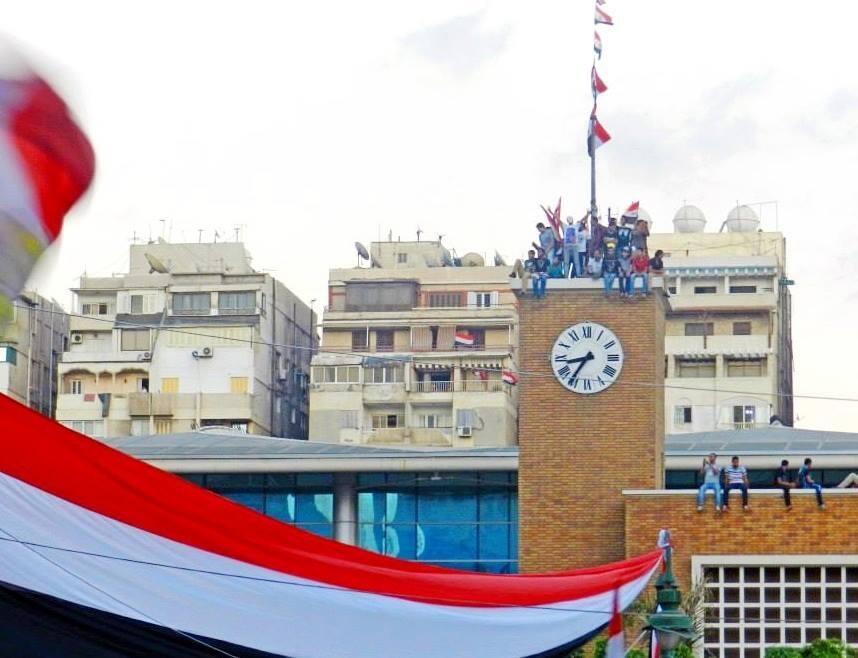
[Tamarod protesters "conquer" Sidi Gaber train station on 2 July 2013 Via Alexandria FB Page]
Sidi Gaber evolved as the “Switzerland” in Alexandria’s revolutionary discourse. It came to be seen as a nonpartisan public space. The area of Qa’id Ibrahim quickly became entangled with the Muslim Brotherhood and other Islamist factions, so much so that revolutionaries have grown increasingly hesitant to gather and commence their marches from there. The grounds of al-Haqqaniyya Court in Mansheya attracted revolutionary actors due to the frequent court sentencing of activists. Consequently, Sidi Gaber became the neutral grounds in which no group had a monopoly over the space. Moreover, the coffeehouses provide rest and heated political discussions, while patrons watch the latest official statements on café televisions. As activist Radwa notes: “Sidi Gaber is neither elitist nor sha’abi [working-class], but middle of the road.”Yet there is a convenience factor that arises from Sidi Gaber. As Radwa noted:
It initially became significant for purely practical reasons during the eighteen days, and it was right in the middle of Alexandria. In the first couple of days we would often end up in Mahatet Masr after our protests. But with the curfew, lack of transportation, and constant stops by the taxis and microbus drivers, we needed a meeting point that would make it easy and fair for all to be able to walk back home—which the majority of us did. Sidi Gaber leads to the corniche and the districts that most activists live in, so geographically it is kind of perfect.
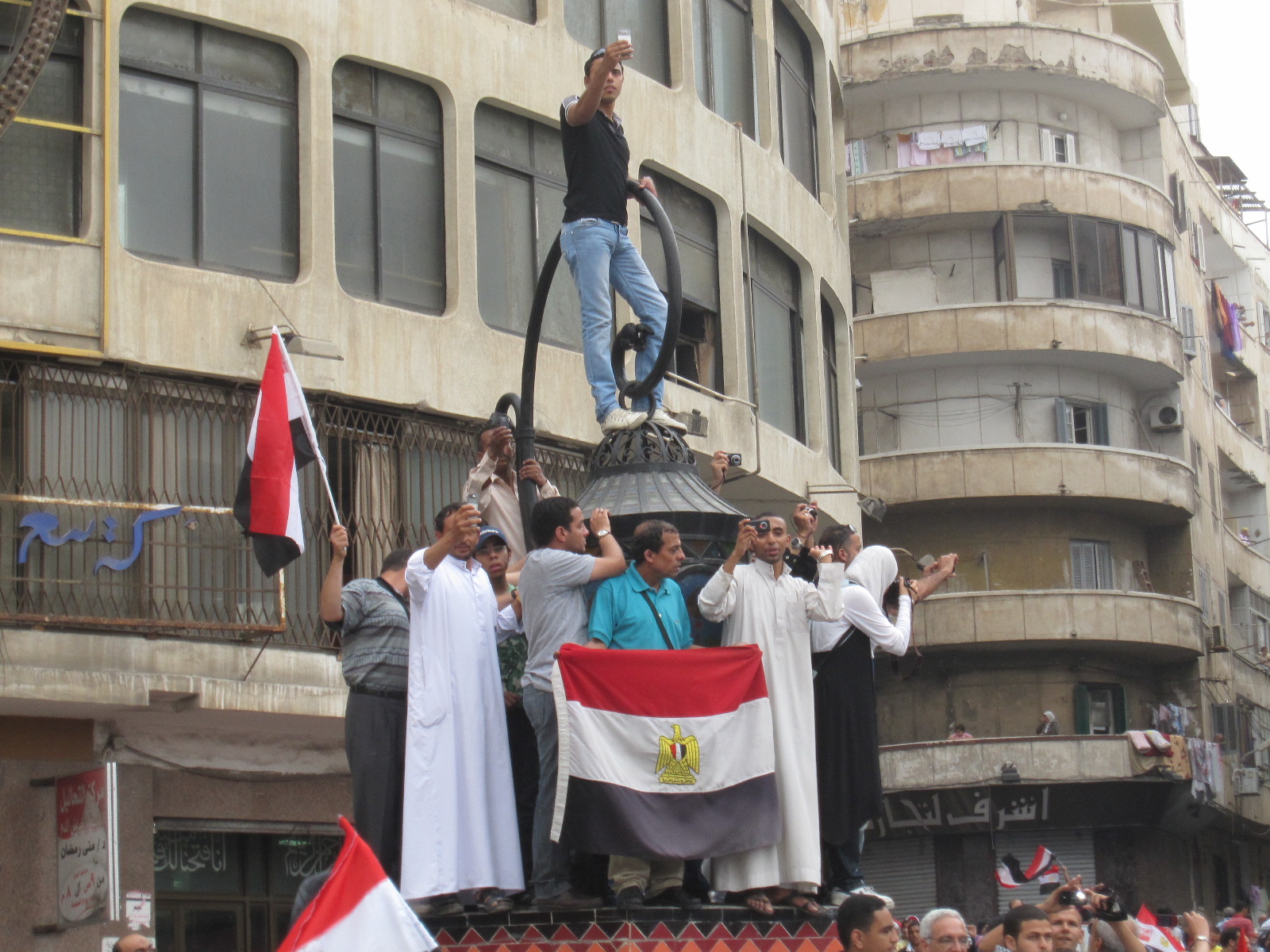
[The less confrontational early days: protestors, calling for the cleansing of former regime remnants, climb upon a large lantern in Sidi Gaber on 27 May 2011. Photo by Amro Ali]
If there is a “revolutionary Alexandria,” then Sidi Gaber is certainly its intersection. The area provides direct access to the hated security directorate in Smouha. As one activist noted:
While the military building became the final destination of all our protests, it also enabled protesters who wanted to go to al Mudiriya (security directorate) in Smouha. It is easier to walk to from Sidi Gaber, and it is this proximity that witnessed many acts of protest against the police apparatus. So we have a history from here [Sidi Gaber] that is connected to all phases of the revolution so far.
Nor is this factor lost on Alexandria’s security sector, which explains in part why the Sidi Gaber police station earned a hated reputation in the governorate as it menacingly policed the public in the hinterland surrounding Smouha’s security directorate.
The unfolding events and narratives over the past three years kept reinforcing Sidi Gaber’s importance. Arguably, the first sign of turbulence started in June 2010 when two police officers from the Sidi Gaber police station killed Khaled Said. The brutal incident took place several blocks away in Cleopatra Hamamat. Revolutionary, and even Islamist, protesters have made it a ritual to pass through Cleopatra Square to chant Khaled’s name before they commence onto their final stop at the military base.

[Armoured vehicles arrive during the 5 July pro-Morsi protests via Alex Eyes]
Historically, Sidi Gaber is no stranger to violence and mythmaking. An aging resident, Magdy, tells me, with a solemn wisdom that I rarely encounter, the name Sidi Gaber was a Moroccan Sufi who settled in Alexandria several centuries ago as part of a long history of waves of Moroccan and Andalusian migration to Alexandria. The man tells me of a local legend, that in June 1940, the ghost of Sidi Gaber saw the Axis warplanes approach as they were about to bomb the British military installations, which are today the very same Egyptian military command. So as to protect his name-bearing Sidi Gaber Mosque, he waved the planes away and consequently—the story goes—all the bombs fell on nearby Cleopatra Hamamat in the first week of the campaign. Yet it seems the ghost of Sidi Gaber must have retired long ago.
Last December, I noted the ways in which violence gripped Alexandria as a result of the divisive constitutional referendum. Protest marches continue to evolve in the coastal city due to the inability of an Alexandrian public space large enough to accommodate incoming protesters, certainly not like Tahrir Square. What further aggravated the degree of deadly violence this month was that Islamist forces have followed the revolutionary protesters’ model of starting their marches from both ends of the city—Qa’id Ibrahim in the west and Victoria in the east—and marching to meet at Sidi Gaber.
The growing implication for the rest of Alexandria is the perception that Sidi Gaber is the place to amplify one’s message and possibly bring about change. Based on interactions on the ground and a close reading of Alexandria’s social media, I feel that tweets and text messages emanating out of this area can at times overstate the problems unfolding on the streets. As a consequence of such messages and signals, the subsequent wave of protesters arrives throughout the day on the presumption that the situation is escalating. This could explain why these protesters are often more armed than those earlier in the day. In effect, the violence becomes a self-fulfilling prophecy. To make matters worse, almost all parties believe the security forces are doing the other side’s bidding. Protesters enter the Sidi Gaber bubble with a persecution complex. While in the past, protesting was decentralized, it is becoming increasingly acute in one area at the expense of the rest of the city.
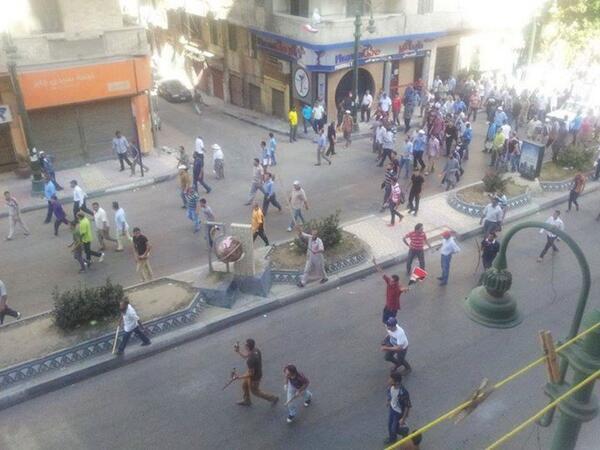
[Later wave of Pro-Morsi supporters show up in Sidi Gaber on 5 July 2013 Via Alexandria FB Page]
The electoral politics of the area is perilously skewed from the rest of the city’s voting patterns and actually pits residents against incoming protesters as I have noted before. In the December 2012 constitutional referendum, the residents rejected the poll vote on the Islamist-drafted constitution when they specifically in all the surrounding districts that fall under the Sidi Gaber jurisdiction, gave a resounding “no” vote that triumphed 56746 to 32540, interpreted as a defeat for Islamists in a strategic zone of Alexandria. Nonetheless, the area strikes me as being dominated by mixture of sympathies towards revolutionaries, secular conservatives, and, lesser, Brotherhood and Salafis, making it a toxic environment when the “wrong” type of protesters come by. That could mean anybody. I shot the below video in Cleopatra, which highlights the impact of secular and Nasserist presidential candidate Hamdeen Sabahi winning in Alexandria. Many revolutionaries felt emboldened, and went about tearing down posters of Morsi in a mass nationalist frenzy. From then on, Islamists in this area were perceived to be in a disadvantaged position.
[Pro-Hamdeen Sabahi protesters arrive in Cleopatra Hamamat and Sidi Gaber on 5 June 2012, destroying all symbols of the Brotherhood. Video by Amro Ali]
Resident Reem Hewedy noted that Sidi Gaber went through a lull period (with the exception of December 2012 clashes) during the Morsi presidency due to the focus being taken away from the military. With the toppling of Morsi, the military is clearly back in the picture, and some would argue, has never left. Sidi Gaber’s role will only increase as Alexandria’s pro-Morsi supporters hold the armed forces responsible for the ending of the Islamist project, therefore it is likely more protest marches will take place here. Likewise, once the anti-Islamist forces honeymoon period with the security sector comes to an inevitable end, they will gravitate back towards Sidi Gaber not just as a reactionary measure against Islamists, but to resume the traditional anti-SCAF protests.
Despite the significance of the area, residents exhibit a suspicion and pessimism that has come to characterize the landscape. Questions are often thrown at me: “Why do you do what you do? Why do you have to write and photograph everything that happens here? Why do you mix yourself with those trouble-making revolutionaries?”
It is always an uphill battle to try and get them to see Alexandria’s tomorrow rather than its today. Idealism does not have many friends here. When they become adamant, that change is impossible. You then need to remind them that change is always closer than they think, and point in the direction of the dusty Internet café where Khaled Said was confronted and killed a few meters away.
One landmark that has weaved itself into my life trajectory happens to be the timeless Sidi Gaber train station. Its presence always represented the start of a journey to Tahrir Square. The station for the past two and a half years has played a dual role. On departure, it symbolized a journey of hope, on my return, the homecoming.
At one point, I could not help but be reminded by the reverse in Naguib Mahfouz at Sidi Gaber - Reflections of a Nobel Laureate, 1994-2001. The literary legend Mahfouz often compared Sidi Gaber to the advanced stages of life, as he notes:
The journey of life - well, with the approach of my ninetieth year I feel I am passing the penultimate station, Sidi Gaber station, as it were. When I went to Alexandria by train, I would always get off at Mahattat Masr, the last station on the line. So when I passed Sidi Gaber station I could afford the comfort of knowing that I wasn`t getting off quite yet. But I also knew that I was edging closer and closer to Mahattat Masr, that it wouldn’t be long before I had to pack my luggage and get ready to exit the train. This is what my birthday feels like this year: it is like passing Sidi Gaber station on the train.
As national uncertainty continues to unfold, it can only be hoped that Sidi Gaber represents the last stages in the life of the old order, rather than the finitude of the revolution’s life.
I find the answer soon enough upon glancing at the throng of protesters in Sidi Gaber and realizing, these are people who have forgotten what fear is.
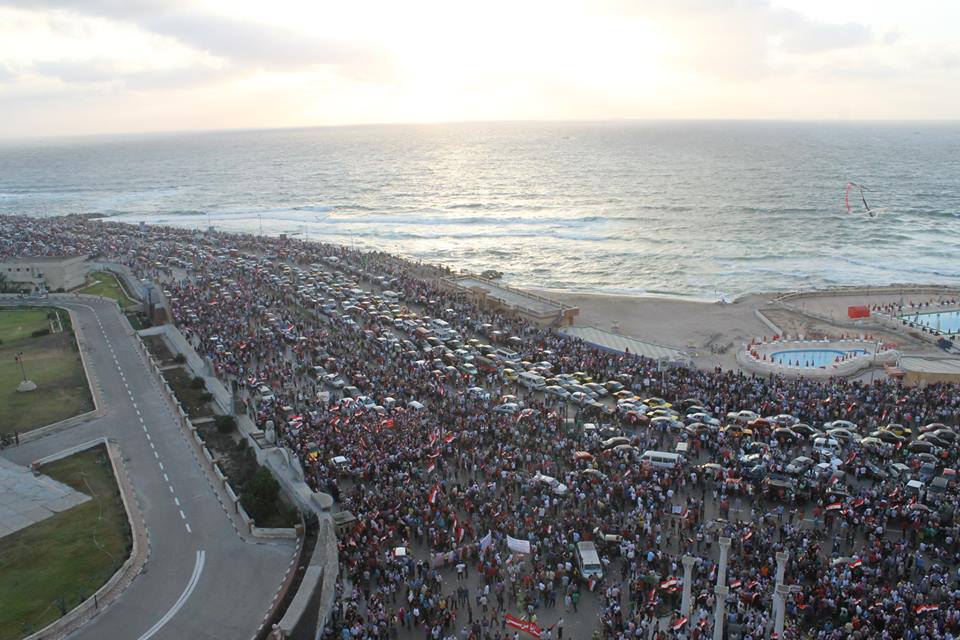
[Anti-Morsi protestors flooding into Sidi Gaber from the coastal side,3 July 2013 via Alexandria FB Page]